|
Thurlby
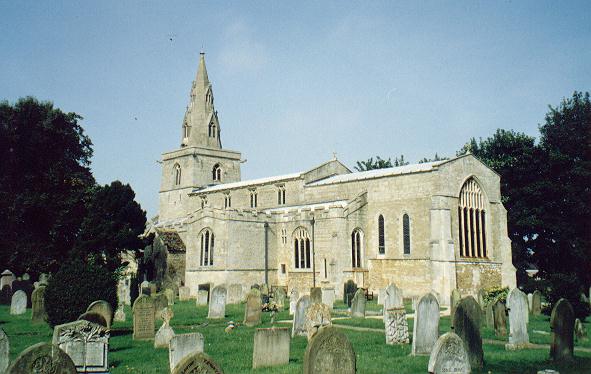
The village of Thurlby straddles the A15 two miles south of Bourne.
One thousand years of history are reflected in the village church and 1,000 more
in the Car Dyke which runs nearby, a reminder of the Roman occupation of
Britain. The name is mentioned in the Domesday Book of 1086 as Turolvebi
but by 1207 it had become Thurleby, meaning
Thorulf's farmstead or village.
The Car Dyke marks the edge of the fen and the line of villages is set back a
short distance where stone is still the predominant building material but at
Thurlby it has given place to brick for most of the dwellings.
|
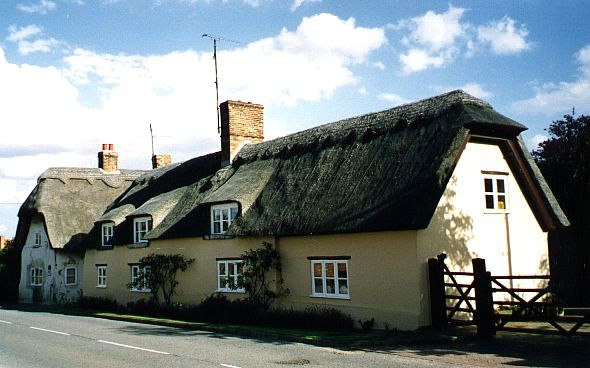 |
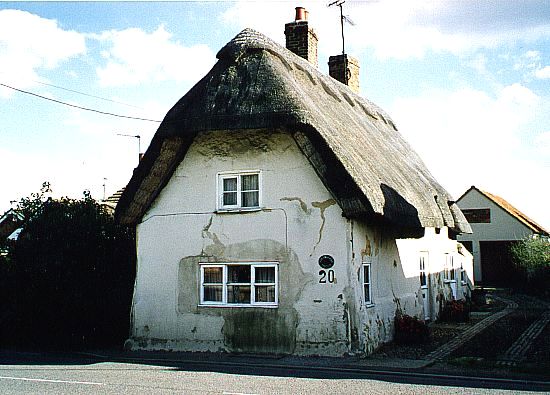 |
|
Two
thatched cottages, the
Cottage and Strawberry
Thatch. |
The
old tradition remains and one the attractions of the village is its ancient thatched cottages. Two stand next door to each other in the main street, one with yellow walls and known simply as The Cottage, while the other has been given the evocative name of Strawberry Thatch.
A third, also in the main street, has pink washed walls with a tiled roof extension.
The church can be found on the other side of the A15 and is tucked away in a lane alongside the Car Dyke, well maintained and surrounded by a spacious churchyard with the west windows overlooking the fens. The tower may well have Saxon origins and could have been built as a fortress as well as a sanctuary and the patron saint is St. Firmin, first bishop of Amiens who was martyred early in the 4th century, and Thurlby is one of the few churches with his name.
A restoration programme for the church windows began in 1992 and the east window
has just been completed at a cost of almost £5,000. This window with its intricate decoration of Victorian stained glass was originally installed in 1860 by Thomas Cook Hubbard of Thurlby Grange in memory of his ancestors and his two wives Sarah and Mary.
|
THE NAVE OF ST FIRMIN'S CHURCH |
|
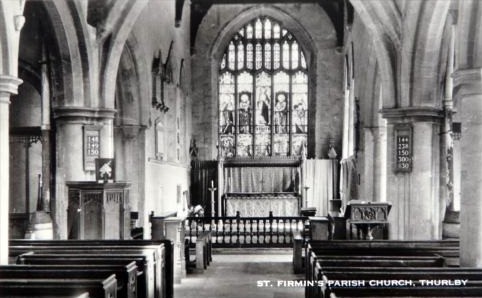 |
|
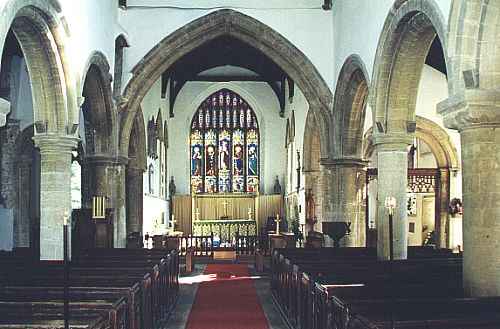 |
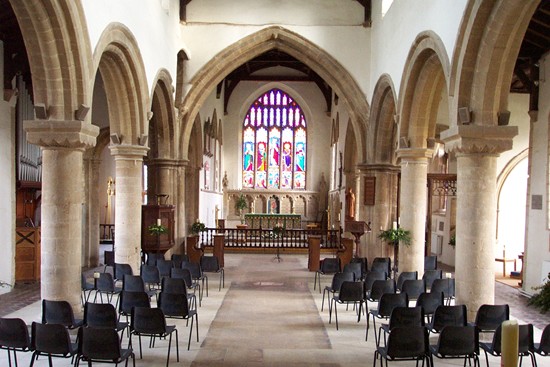 |
|
The
nave of St Firmin's Church in 1950 (top), before refurbishment (middle)
and after the Victorian pews were removed in 2005.
|
In 2005, major improvements were made to the church at a cost of
£110,000 provided by local fund-raising and financial assistance from the
Historic Churches Preservation Trust. The building was closed for three months
from September while the work proceeded. It included the restoration of
woodwork, including the replacement of the Victorian pews, which had been affected by dry rot,
with chairs, the
installation of an under floor heating system and the replacement of the wooden
floor by traditional flagstones. The church re-opened in December with a service
of blessing and re-dedication by the Bishop of Lincoln, the Rt Rev John Saxbee.
|
By the side of the south porch is a stone
plaque carved with a Latin motto on mortality which,
translated, means:
NONE IS DEAD BUT MERELY CHANGED. |
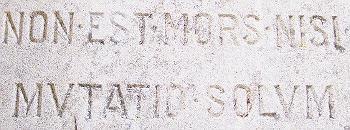 |
A substantial private house built in the High Street during the 19th century was bequeathed by the owner to the Youth Hostels Association
which runs a chain of similar hostels throughout England and Wales and was
eventually used for that purpose, accommodating visitors from all over the world arriving to see the sights of Lincolnshire. The house called
Capstone was opened as a hostel on the May Day Bank Holiday, Monday 4th May
1981, by Mr Hedley Alcock, national treasurer of the YHA, and provided
accommodation for 30 overnight visitors in three dormitories. There was
also a kitchen for them to cook their meals, a comfortable common room, a small shop,
drying room, shower and other facilities and spacious grounds.
The
property, predominantly Georgian and Victorian in style, was built on the site
of a 15th century blacksmith's forge. It was left to the association in the will of Mr Harry Garwood Sneath, a
prominent farmer and businessman who died in February 1979 and whose family had lived there since 1862. He also left £4,000 towards the cost of converting the house for its new role, work that was carried out by local building contractors although the decorating, equipping and fitting out was appropriately completed by youngsters employed under the government's Youth Opportunities
Programme.
The
grounds originally covered 1½ acres but a large area was later
sold off by the YHA for residential development and in March 2002, it was
announced that the house itself was to close as a hostel at the end of the
summer season and sold as part of a cost-cutting exercise in the wake of
the recent foot and mouth crisis which caused a dramatic drop in tourism
and countryside activities the previous year and resulted in a £5 million
shortfall in their business nationwide.
The decision provoked an outcry in
the village and elsewhere because the closure was not in keeping with the
wishes of Mr Sneath who bequeathed the house and would also affect
travellers seeking overnight accommodation and businesses in the
village and services in the area. After protracted negotiations, a rescue deal was worked
out in conjunction with South Kesteven District Council and Lincolnshire
County Council and refurbishment work began in the summer of 2005 at a
cost of £650,000 and completed in the spring of 2006. The new look hostel
has 30 bedrooms with additional
facilities for the disabled and extra car parking space. County council
project manager David Woods explained: "We have turned the building from a
basic hostel into something that offers accommodation in smaller, more
private rooms and which will carry at least a three-star rating. The
facility is now being leased back to the YHA."
The project has been so successful that in August 2006, the
Rotary Club of Bourne nominated the community for its annual rose bowl
award, handed out each year in recognition of an outstanding contribution
to the environment, The silver trophy, which will be kept for one year,
was presented to the hostel manager, Suzanne Donohue, at a special
ceremony by the Rotary Club president Mr Joe Yau. "We are doing fabulously
well since the revamp and are actually booked up every weekend between now
and the New year which is quite incredible", she said. "The youth hostel
is a vital part of this community and we hope to be a big part of the
area's tourist industry for many years to come."
|
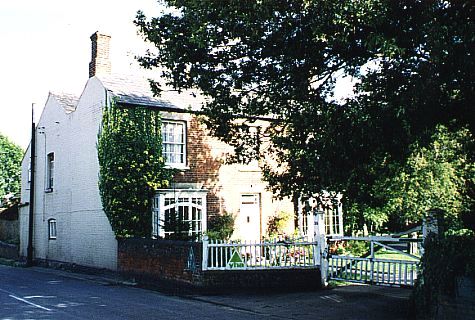 |
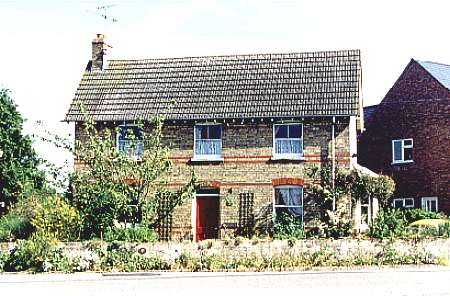 |
|
The
house known as Capstone, now a youth hostel, and the old school
house, now a private home. |
|
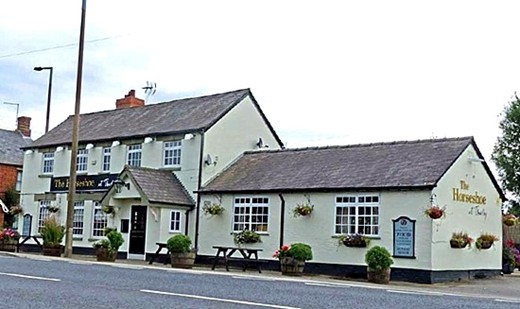 |
|
Like most English villages, Thurlby has had a
number of public houses but only one remains, the Horseshoe which
stands on the main A15. There have been others, notably the Five
Bells, the Bluebell, the Bell., the Tennyson Arms and the Crown Inn
in Crown Lane, now demolished and replaced by a private house. The
Horsehoe dates from the early 19th century and in 1842 it was known
as the Horse Shoes when the landlord was John Goodacre but by 1930
it had become the Horseshoe, landlord William George Gough. At one
time, the hostelry boasted one of the top quoits teams in the
country and in 1961 even hosted an international match between
England and Scotland. |
Thurlby Manor
is situated to the south west of the church and is now divided into two dwellings separated by a hedge. The lower central section dates back to the early 17th century and the east wing is early Georgian with moulded and keystoned windows and a comfortable looking Restoration type of roof. On the front of this wing is a tall, arched stairlight and on the east front a protruding chimneybreast. The north front is symmetrical: two bays, two storeys and quoins. The entrance in the centre wing suggests a normal 17th century plan. The west wing was rebuilt after a fire in 1878. In the garden there is a pleasant vernacular barn with steps leading up to the loft.
During the 1970s, the house was the home of the brothers Arthur and Noel
Ward whose grandfather bought it 60 years before from the Earl of Ancaster.
Mr Arthur Ward was a keen collector of everything connected with horses
having a room entirely devoted to harness, amulets and figures of horses.
|
THURLBY GRANGE FARM |
|
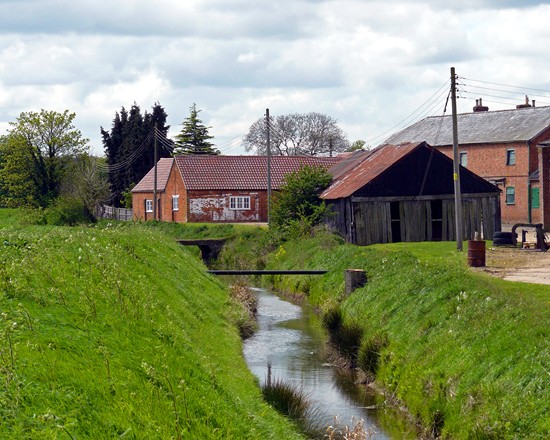 |
|
Thurlby Grange farm has had a varied history and
records indicate that it was owned by Anthony Hardolph Eyre in 1795-96.
The estate was bought by the Duke of Portland on 3rd May 1830 as part of
an exchange between him and Mr Eyre (1757-1836) and in 1912, the 6th Duke
of Portland sold it to Robert Kemp. There is also evidence that the land
was rented out to Thomas Cook Hubbard who is listed as living at Thurlby
Grange in the 1851 census, then aged 62, with his wife Hepzibah, aged 48,
and is described as a farmer with 300 acres and employing ten labourers.
White's Gazetteer for 1856 also says that Mr Hubbard had built a small
chapel for the Particular Baptists at Thurlby eight years previously and
that his son, William Hubbard, also lived there and worked as a farmer and
brick maker. The estate remains a farming
enterprise today and the current tenant is Mr A J Reynolds. The waterway
which runs nearby is the Car Dyke, built by the Romans 2,000 years ago and
still in service for land drainage. |
The earliest record of a school at Thurlby is 1585 but a church school was built in 1853 and attended by eighty pupils.
A house was also built for the schoolmaster and funded voluntarily with grants
from various sources including the Provost and Fellows of Eton College who were
patrons of the living of Thurlby (£25) and the Baillie stained glass works in
London which had made windows for the church (£5) while other fund raising came
from amateur concerts in the schoolroom and by 1862 the debt had been reduced to
only £20 which was cleared soon afterwards. The heating conditions at the school
were poor and as a result of the Education Act of 1870, a new building was
erected, controlled by a board of local parishioners. It was called the Board School and opened in 1878.
The standard of punishment for bad behaviour was severe and varied according to the offence and usually consisted of several strokes of the cane by heavy handed schoolteachers exasperated by the wayward conduct of their pupils who would rather have been out in the fields and the fresh air than confined to their slates to learn the three R's. Discipline was strictly enforced in this manner from the opening of the school until World War I when less rigorous methods were introduced.
The 19th century buildings were replaced by the present village school in the late 1980s when the old school premises were sold off by Lincolnshire County Council. The actual school room and playground were demolished and cleared and new houses built on the site but the school house where the headmaster lived, which is pictured above, was turned into a private house, as it is today, and a stone tablet has been preserved on the gable end recording that it was erected during 1877. Both properties were built with the yellow bricks much favoured by the mid-Victorians although the original blue roof slates that were also used for such buildings have recently been replaced on the house by modern tiles. Villagers still remember the old school as a large building with an assembly hall at the front, a corridor running its entire length and classrooms and a kitchen leading off, with the large playground at the rear, and there is much sadness that such a fine Victorian building was allowed to disappear in this way.
Schools today provide facilities and freedoms undreamed of by those generations of children who attended this school at Thurlby and so the building that remains is not only part of the village's heritage but also a reminder of the changing conditions for the education of our children over the years.
|
THURLBY'S CHAPELS |
|
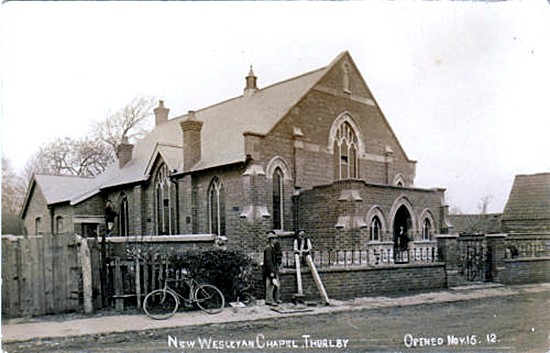
The new Wesleyan Chapel photographed during the
completion of
building work in 1912 by Ashby
Swift.
THE PLANS for the
new chapel included two vestries and a Sunday school and provided
seating to accommodate more than 250 people. The building was to
be constructed in the Gothic style using Walden and Corby
Freestone and Bytham red brick with a slated roof. The contract
for building the High Street chapel was awarded to Thurlby builder
Fred Brutnell and his uncle, William Clegg, of Corby Glen. Fred
Brutnell was also responsible for running the family farm, this
enabled him to divert men, horses and carts, from farm work to the
chapel site.
Work began on 18th May 1912 when top soil was carted from the
site. By the beginning of June, five men were working up to 10
hours, six days a week at the site, with others helping as
required. Although carting and the haulage of bricks and timber
was contracted to Messrs Sneath and Son, Joe Brutnell with a horse
and cart also collected some building materials from Stamford. Joe
also carted bricks from Thurlby railway station.
Work progressed well but on June 12th Fred and John Brutnell, Mr
Cragg and four workmen, found it necessary to spend most of the
day at the chapel, preparing for the stone-laying ceremony. Later
that day, Alderman T Wallis of Lincoln, presided at the stone
laying service. After a short address eight principal stones were
laid.
The stonelayers included Alderman Wallis, Wesleyan Methodist
Circuit Minister, the Rev James Drummond and the longest serving
local preacher (nearly 60 years) Joseph Bryan, of Thurlby. This
was followed by the laying of nearly 50 more stones "by a number
of friends connected with the Wesleyan cause in Thurlby and in the
Circuit."
Among them were Edward Stubley, on behalf of the Bourne Circuit
Wesleyan quarterly meeting; Thomas Barnes, representing the
Wesleyan Circuit local preachers, and Mr Rowe on behalf of the
Sunday school at Thurlby. The building contractor, Fred Brutnell,
a Thurlby chapel trustee and Mr Wright, on behalf of the workmen
employed in the building, also laid stones. After the laying of
the foundation stones to the front and sides of the chapel porch a
tea was held in the public hall which was well attended and was
admirably managed by a ladies committee.
Bourne Circuit preachers plans from 1912 and 1854, the year in
which Thurlby's Free Methodists split from the Wesleyans, together
with The History of the Scheme and Methodism in the Village plus
various publications and newspapers were all sealed in a jar and
placed in the chapel foundations. This time capsule records the
first century of Methodism in the village.
The chapel building, virtually unchanged, marks the second century
and represents the sound foundations formed by past congregations
for future generations.
NOTE: Article by Joyce Stevenson reproduced from
the Stamford
Mercury on Friday 24th August 2012. |
|
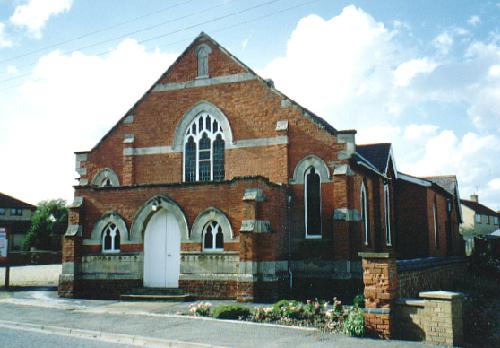
The Methodist Chapel as it now is |
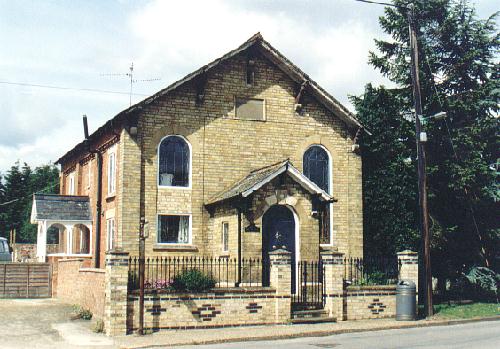
Thurlby
"Top" Chapel built in 1861 |
Methodism
was introduced into the village around 1810 by the Hayes family and for
the first twenty years, services were held in cottages and barns. A Sunday
School was started in 1830 and the first Wesleyan chapel was built in 1832
to hold 150 people on a site in the High Street given by the Jackson
family who worked as blacksmiths and shoemakers. The total
cost of the building was £311 12s. 8d. which included £1 5s. 0d. to dig
out the foundations. By 1851, there were 60 adults at Sunday afternoon
services and 40 in the evenings. The singing was at first accompanied by a
small orchestra consisting of string and woodwind instruments, such as
oboe, cello and violin, but a pipe organ was installed in 1852 and later a
harmonium, succeeded in 1902 by an organ.
The
present red brick Methodist Chapel was built in the High Street in 1912 when the old
one was deemed to be unsafe and a new site was donated by Sir John Lawrence. The
building was designed in the Gothic style by William Hinson of Stamford
and had room for 250 people with a schoolroom and two vestries and was
built by Mr F Brutnell of Thurlby at a total cost of £853 11s. 1d. A
stone laying was held on 12th June 1912 and a jar was placed in the
foundations containing copies of Methodist documents and local
newspapers. The chapel was opened on 15th November that year by
the Rev F Luke Wiseman, president of the Methodist Conference. A new
church hall was built in 1977 at a cost of £10,000 and the Thurlby
society continues to thrive.
There
was however a split in Methodism in the village in the early 1850s when
the Reformers, as they became known, broke away from the mainstream
congregation and after holding meetings in a barn in Whitechapel Row,
built their own chapel in 1861 on a site bought from John Fields for £25.
It
was constructed at a cost of £280 with the distinctive yellow brick façade, red brick side walls and blue slate roof used in other village chapels in the area, notably that in Dyke
village, and became known as the "Top Chapel" because of its
situation in the top end of the village. A schoolroom was added at the
rear in 1903 and continued in existence until 1970 when the trustees
decided that Thurlby was not large enough to support two Methodist chapels
and the Top Chapel closed. The building was left standing empty for
several years when it was sold for residential development and the new owners have
turned it into a home that has been given the name Kirktom House although they have left much of the exterior intact.
The village once had its own railway station on the Essendine and Bourne branch of the Great Northern Railway but it has since closed and is now a council depot and all that remains is the platform.
(See box below).
|
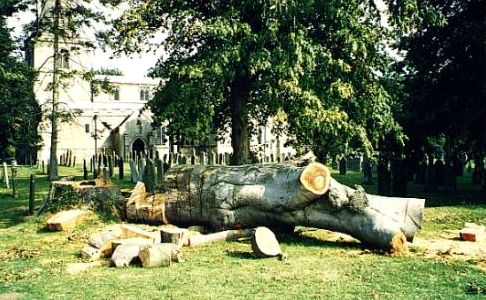 |
|
ANCIENT TREE FELLED IN CHURCHYARD
A massive beech tree that had dominated the churchyard at Thurlby for
the past century was cut down in the summer of 1998. High winds ripped off one of its huge branches during a storm and several gravestones were damaged when it fell on them. Church officials then decided that the tree was a potential danger and should be removed as a safeguard.
Ring dating tests estimated that the beech tree was 110 years old which meant that it was planted around 1888 when Queen Victoria was on the throne and Jack the Ripper was terrorising the
East End of London.
The tree was eventually sliced into sections and given away to parishioners for firewood. But not everyone was happy with the decision to fell the beech. One parish councillor said: "It should have been left. The tree was quite safe and would have stood for another hundred years." |
|
THURLBY'S NEAT STATION
- a credit to the village
|
|
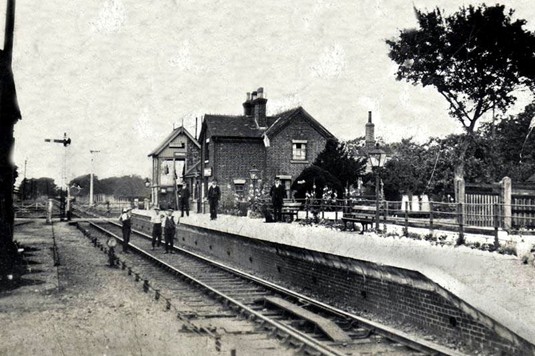 |
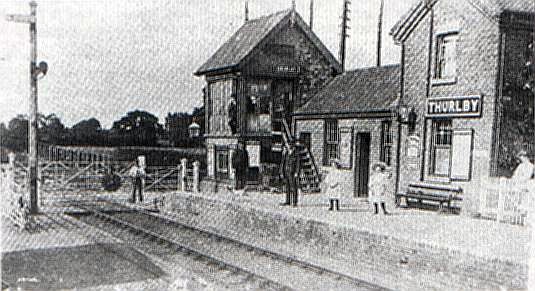 |
|
The railway station at Thurlby circa
1900 (above) and again in 1925 (below).
|
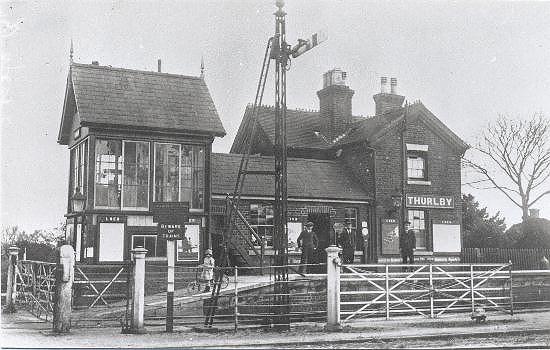 |
|
One
of the prettiest and best kept railway stations in South
Lincolnshire was at Thurlby and this item about it appeared in the
Stamford Mercury on Friday 18th October 1935 in the Gossip
Grave and Gay column contributed weekly by a writer under the
pseudonym Strongbow:
Nothing
pleases me more than to see a neatly-kept railway station. As a
rule, I always think of a railway station as a bleak, draughty
sort of affair, reminiscent of a seaport wharf. Most of them are
dirty, dark, sooty and altogether objectionable places. But I have
in mind an outstanding exception to the rule. I refer to Thurlby
station. Here a pleasing colour scheme has been introduced to good
effect. The station looks light and airy and, above all, clean.
There are plenty of flowers, especially in the summer months.
Window boxes are numerous and there are also boxes for flowers
along the edge of the platform. The name of the station is plain
to see on one bank, prettily executed in coloured pebbles. True,
Thurlby is a small station with not a large number of engines
passing through it to make things dirty but nevertheless, it is a
credit to the village and its example might well be followed by
other stations in the locality. |
|
THURLBY IN PAST TIMES |
|
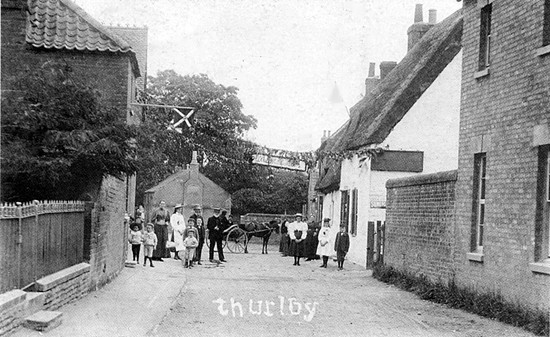 |
|
Long Drove near the village crossroads from a
picture postcard taken in August 1902 during the village celebrations for
the coronation of King Edward VII. |
|
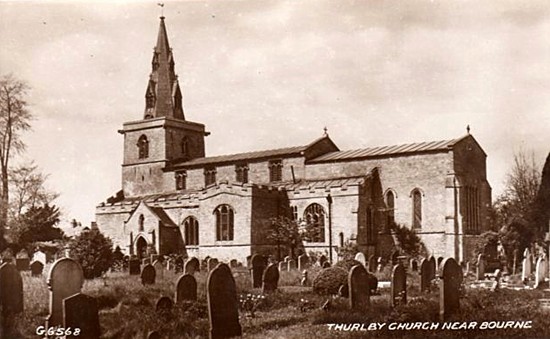 |
|
St Firmin's Church from a picture postcard
published circa 1930. |
|
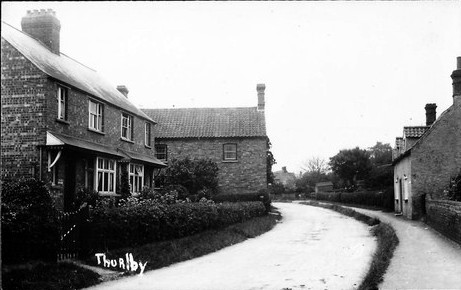 |
|
High Street, Thurlby, photographed for a
picture
postcard around 1950. |
|
FROM THE
ARCHIVES The new organ lately erected in the
church at Thurlby, near Bourne, was opened on Sunday last when an
eloquent discourse was delivered by the Rev W E Chapman, of Edenham.
The church was crowded. Many families were present from Bourne and
the villages adjacent to Thurlby. £10 was collected at the doors
after the service. This sum, with the handsome donation of the
worthy vicar (who has given half the price of the organ), and the
subscriptions previously collected from the inhabitants of the
parish, will, it is hoped, prove ample for the payment of all
expenses connected with its erection. - news item from the
Stamford Mercury, Friday 12th July 1833. The dwelling house of Mr Robert
Browning, of Thurlby Northorpe, near Bourne, was broken into on the
night of the 28th ult. The thieves affected an entrance through a
window and managed to remove from the premises without being heard a
silver pint mug, two silver spoons, six loaves of bread, four
bottles of ale and a pig's chine. - news item from the Stamford
Mercury, Friday 10th January 1851. There
are now living at Thurlby, near Bourne, 22 individuals (20 of whom
are natives) whose united ages amount to 1,766 years, being an
average of above 80 years each. - news item from the Stamford
Mercury, Friday 28th February 1851. TO
MILLERS
To be LET from year to year or for a term of years
An excellent POST WINDMILL adjoining the turnpike road from Thurlby
to Bourne. Apply to Mr Hubbard, Thurlby Grange, Bourne. - public
notice in the Stamford Mercury, Friday 23rd May 1851.
A TRIO OF VENERABLES: At Northorpe, near Bourne, during the early
part of the month, assembled a small party consisting of three
brothers whose united ages were 248 years; the eldest being 87, the
second 83 and the third 78. These brothers have generally dined
together once a year but at the last meeting one was absent until
tea-time. - news item from the Stamford Mercury, Friday 17th
October 1851. Thurlby Provident Association.-
This society celebrated its 22nd anniversary on Monday last. Divine
Service was attended by members of the parish church at 12 o'clock
and an appropriate sermon was delivered by the Rev E Chapman, of
Swinstead, from Romans 12, v. 9. The club afterwards dined at the
Bell Inn, under the presidency of the Rev C P Worsley. From the
statement of accounts produced by the Secretary, the society
consists of 64 members and possesses a fund of £315. The Chairman
congratulated them upon their position and the good they were the
means of effecting.
- news report from the Stamford Mercury, Friday 22nd May 1857. Lieutenant Pennyman W Worsley, son of the Rev C
P Worsley, Vicar of Thurlby, is with his regiment, the 60th King's
Royal Rifle Corps, in Canada. The officers of the Quebec Rifle Club
have recently presented him with a testimonial, consisting of a
silver tea pot, coffee pot, sugar boats, salver &c., as a token of
their high esteem for his valuable assistance in organising their
club. Lieutenant Worsley is doubtless a valuable acquisition to the
profession he has chosen and such a mark of approbation to so young
an officer must be very gratifying to him.
- news report from the Stamford Mercury,
Friday 26th December 1862. On Friday
morning last, Mr James Creasey went to Thurlby station intending to
take the train to Bourne. On reaching the platform the train was
moving off and in attempting to get into the guard's van he lost his
foothold, and hanging by the van was dragged along the platform some
yards. After the van had cleared the platform he left his hold and
fell to the ground and had one of his legs broken.
- news item from the Stamford Mercury, Friday 1st October 1875. Mr and Mrs
Robert Savage were married at Thurlby church on 14th July 1857. They
made their home in the house in which Mrs Savage had lived up to
that time and the fact that she has never lived anywhere else makes
the event of their diamond wedding doubly interesting. In this
cottage, Mr and Mrs Savage have brought up a large family, all of
whom, with the exception of two, are alive and doing well. The aged
couple enjoy excellent health despite the fact that both are nearly
ninety years of age. - news report from the Spalding
Free Press, 17th July 1917. |
|
PHOTO ALBUM |
|
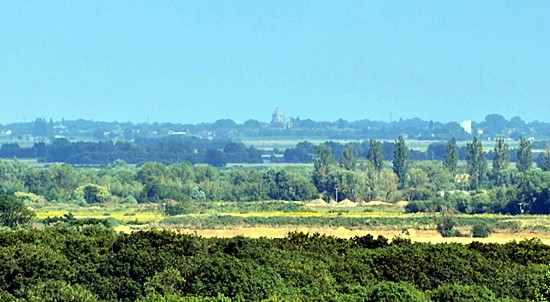 |
|
Swallow Hill at Thurlby is one of the highest
points in the Bourne area and the 11th century Crowland Abbey, ten
miles away as the crow flies, can be seen on a clear
day (above), as can the water town at Spalding (below) which is a
similar distance. |
|
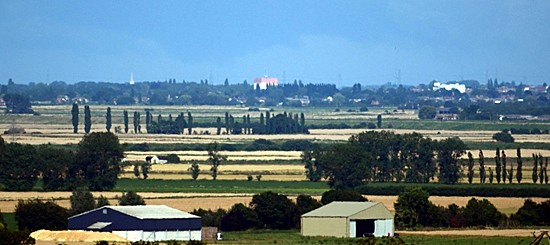 |
REVISED MAY 2014
See also
Henry
Andrews Sneath
John Elwes Noble
Marjorie Noble MBE
Lewis
Sommerfield Thurlby in
past times
Thurlby's war dead 1914-18
The Car Dyke
Church pews and bench
ends Tying the knot at
eighty
Sir
Malcolm Sargent at the organ of Thurlby church
The ghost of Thurlby vicarage Walking Thurlby Fen Slipe
For
details of the 1916 Airship Disaster at Thurlby
see Dr John Gilpin
For
details of the Thurlby Total Abstinence Society
see Temperance and the evils of drink

Go to:
Main Index Villages
Index
|






















